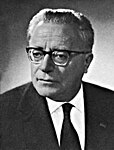Italian general election, 1953
|
|
|||||||||||||||||||||||||||||||||||||||||||||
|---|---|---|---|---|---|---|---|---|---|---|---|---|---|---|---|---|---|---|---|---|---|---|---|---|---|---|---|---|---|---|---|---|---|---|---|---|---|---|---|---|---|---|---|---|---|
|
|||||||||||||||||||||||||||||||||||||||||||||
|
All 590 seats to the Italian Chamber of Deputies and 237 (of the 243) seats to the Italian Senate |
|||||||||||||||||||||||||||||||||||||||||||||
| Turnout | 93.8% | ||||||||||||||||||||||||||||||||||||||||||||
|
|||||||||||||||||||||||||||||||||||||||||||||
 
Legislative election results map. Light Blue denotes provinces with a Christian Democratic plurality, Red denotes those with a Communist plurality, Gray denotes those with an Autonomist plurality.
|
|||||||||||||||||||||||||||||||||||||||||||||
|
|||||||||||||||||||||||||||||||||||||||||||||
Alcide De Gasperi
Christian Democracy
Alcide De Gasperi
Christian Democracy
General elections were held in Italy on Sunday June 7, 1953, to choose the Second Republican Parliament. They were a test for leading centrist coalition ruled by Prime Minister Alcide De Gasperi.
The election was characterized by changes in the electoral law. Even if the general structure remained uncorrupted, the government introduced a of two thirds of seats in the House for the coalition which would obtain at-large the absolute majority of votes. The change was hugely opposed by the opposition parties as well as the smaller DC coalition partners, which had no realistic chances of success. The new law was called Scam Law by its detractors, including some dissidents of minor government parties who founded special opposition groups to deny the artificial landslide to the Christian Democracy.
In the 1950s Italy became a founding member of the NATO alliance (1949), a member of the United Nations (1955) and an ally of the United States, which helped to revive the Italian economy through the Marshall Plan. In the same years, Italy also became a founding member of the ECSC (1952) and of the European Economic Community (1957), later developed into the European Union. At the end of the 1950s an impressive economic growth was termed "Economic Miracle". Italian families used their newfound wealth to purchase consumer durables for the first time. Between 1958 and 1965, the percentage of families owning a television rose from 12% to 49%, washing machines from 3% to 23%, and fridges from 13% to 55%. As noted by the historian Paul Ginsborg
...
Wikipedia



